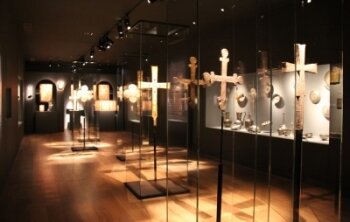Svaneti Museum Meets Visitors in Restored Space
01 August, 2013
 Recently, the Svaneti Museum of History and Ethnography was opened after 2 years of renovations works. General Director of Georgian National Museum Davit Lortkipanidze handed to the first visitor of the museum Mr. Adilar Chartolani, local experienced doctor, a 5-volume edition of Ivane Javakhishvili, titled “History of Georgian Nation”, published by the publishing house Palitra L.
Recently, the Svaneti Museum of History and Ethnography was opened after 2 years of renovations works. General Director of Georgian National Museum Davit Lortkipanidze handed to the first visitor of the museum Mr. Adilar Chartolani, local experienced doctor, a 5-volume edition of Ivane Javakhishvili, titled “History of Georgian Nation”, published by the publishing house Palitra L.The Svaneti Museum of History and Ethnography is almost a hundred years old; its creation came about thanks to the renowned scholars and local activists, who began a campaign to found a museum in order to protect and study the cultural heritage of Svaneti. The Museum of Svaneti was founded in 1936 in Mestia on the basis of the antiquities kept in the church of St. George of Seti.
In the beginning, the museum housed only a small part of collections, but over the years, it acquired various artifacts from different sources. The most fruitful contribution was made in 1948, when famous Georgian art historian, Giorgi Chubinashvili conducted a scientific expedition supported by the entire population of Upper Svaneti; palimpsests, illuminated manuscripts, icons and other antiquities were collected from Svanetian population and from Svaneti churches.
Since the 1970s, regular archaeological expeditions and scholarly researches were conducted by famous archaeologist Shota Chartolani; more than 300 archaeological sites of different periods were discovered in Svaneti, the most notable of which included the highland settlements of Ushguli and Etsera, the necropolis at Larilari and Khaishi citadel and burial ground.
In 1973 the Museum was granted the status of the Museum of History and Ethnography and it became a branch of the State Museum of Georgia. From this time onwards, full scale research and restoration/conservation projects were conducted with regard to the frescoes and icons kept in the museum and churches.
During the 1970s, Svanetian antiquities were researched and listed by an expedition of the Simon Janashia Georgian State Museum of Georgian Academy of Sciences led by Mikheil Chartolani. As a result of the efforts of the expedition as well as of the archaeologist Alexander Javakhishvili, the architectural complex of Chajhash village of the Ushguli commune became a protected site in 1988 (and from 1996, it is listed by UNESCO as a World Heritage Site) as a branch of the Museum of History and Ethnography located in the tower-house.
The museum consists of six halls of permanent exhibitions. The material accumulated by the expedition now forms the core of the unique collections of archaeological, numismatic and ethnographic material, painted and metal icons, crosses and manuscripts. Among the artifacts, there are such masterpieces as the Icon of Forty Sebastian Martyrs, Venice Cross and Byzantine embroidered icon. Adishi Four Gospels, dating back to 897 AD, is the earliest specimen of illuminated manuscript that came down to us, Copied at Shatberdi by Mikael, Commissioned by Abbot Sopron of Shatberdi Monastery.
The Svaneti Museum of History and Ethnography became part of the Georgian National Museum in 2005. National Museum unifies ten of Georgia’s most important museums, which form a rich network of artistic, archaeological, ethnographic and natural heritage. It also includes two research-institutions, or centre’s of scholarly excellence. “We can say that Svaneti Museum is one of the successful projects, one of our six museums that have been rehabilitated. The museum represents a pattern of the regional museum as we envisage it. It is not only the museum but also the research-educational as well as a cultural center. Its collections are very important from the scientific point of view as well as for our history as the history of a Christian nation,” Davit Lortkipanidze, General Director of the Georgian National Museum and leader of the project told Georgian Journal. “These are the collections that still have to be researched, mainly the manuscripts that are dated back from the 10th century. This is the joint success, as around our 100 employees were involved in it. This was the project that united the people of different professions as well as of different countries. Apart from restorers and scientists, it is worthy to mention a really good job that the architect Gaga Kiknadze did, as well as the contribution of our French partner, designer Lina Maria Lopez.”
The mission of the museum is to uphold the highest standards of study, preservation and presentation; to increase public involvement; and to ensure the sustainability of the institution. The highest aim, however, is playing a major role in the cultural life of the region as well as presenting Georgia’s impressive heritage. The designer of the museum is French.
The Georgian National Museum elaborated its holistic approach and developed strategic plan for the Svaneti Museum of History and Ethnography according to international museum standards. This grand-scale renovation process was supported by different international organizations and funds, including Georgian National Commission for UNESCO; European Union; Stiftung Preussischer Kulturbesitz/Staatliche Museen zu Berlin; Smithsonian Institution; U.S. Ambassador’s Fund for Cultural Preservation; Italian Embassy in Georgia; Swiss Embassy in Georgia. The renovation of the Svaneti Museum of History and Ethnography was funded by the Government of Georgia in 2011-2012.





















































